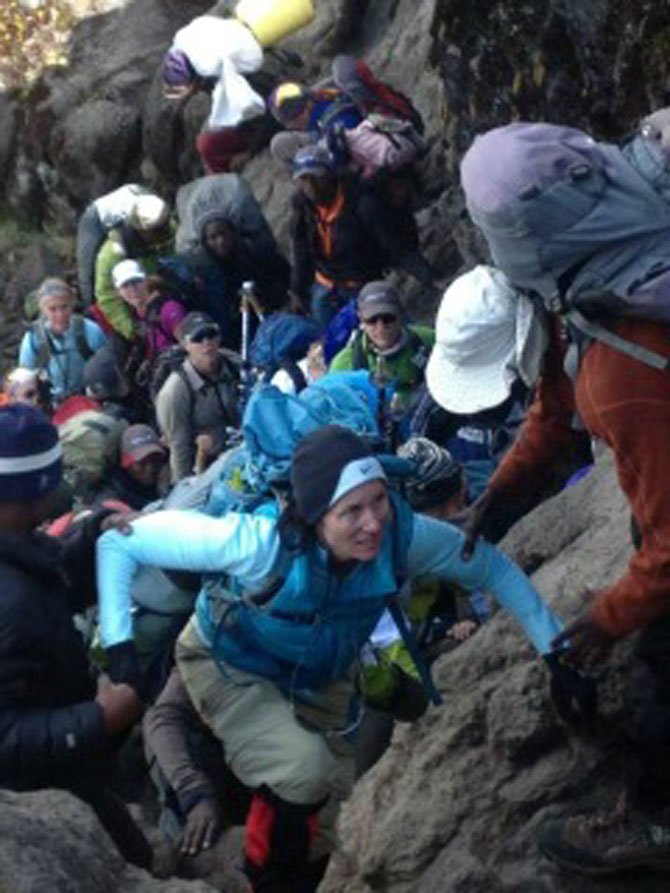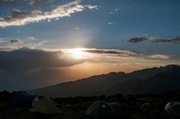Potomac resident Bridgit Fried, just back from a seven-day trek to the summit of Tanzania’s Mount Kilimanjaro, is not afraid of the dark. Facing her fear was part and parcel of climbing “Kili,” as it is referred to by hikers, which, at 19,340 feet, is the tallest mountain in Africa and one of the highest mountains in the world.
A trek to the summit leads the hiker through five different climatic zones, ranging from hot, dry sandy terrain, to leafy green forests and desolate black moonscapes. The culmination of the trek is an arduous eight-hour ascent accomplished during the middle of the night. It is this last part of the journey, made by the light of the trekker’s lone headlamp, that makes attaining the summit of Mount Kilimanjaro a battle that is as mental as it is physical.
Starting point for the technically challenging hike is the tiny town of Moshi, located at the base of the mountain. From here trekkers, plus guides, porters and cooks begin their slow ascent towards the tallest of Kili’s three summits, the Uhuru peak on the Kibo crater rim. Kibo is the only one of the craters that still emits gas from vents deep within its ashy pit. Viewed from afar, the nearly symmetrical cone is surrounded by a 400-foot dune of inky-black volcanic ash and is distinguished by its towering southern scarps capped with snow.
Fried’s company of 17 trekkers opted for one of the six official trekking routes, the Machame Route, which winds its way up and down slowly around the perimeter of the mountain before commencing a steep ascent. Along the way trekkers must first navigate through steamy tropic-like conditions, ultimately trading tank tops and shorts for full cold-weather gear suitable for bearing the brunt of the climb in the upper glacial regions. Abundant rock collapses and landslides obstruct the undulating path, while at the lip of the rocky crater itself, a prohibitive lunar-like terrain awaits, known as the Western Breach. On the western and southern slopes of the mountain, ragged glacial ice flows languidly downward.
All of Kili’s routes are characterized by gaining a considerate amount of altitude over a relatively short period of time. The Machame Route is known for affording the opportunity for better altitude adjustment and incredible views. It also has fewer trekkers than other shorter routes. Altitude sickness is a common complaint, affecting even the most experienced of climbers. Despite this, for many, the biggest challenge to reaching Kili’s summit is psychological, not physical; especially when it comes to relying on the support of your climbing team to press onwards when altitude sickness starts to creep in.
The Machame Gate is located at 10,836 feet and gradually ascends 8,504 feet over seven days to the summit. Roughly half of this distance, or 4,009 feet, is actually gained on “Summit Day,” over the course of a brief eight hours.
Fried’s team started out climbing slowly, shouldering substantial backpacks laden with food and water supplies, while their porters pressed on ahead carrying tents, including a mess tent, porta-johns and other reserves. Most days were filled with six to eight hours of straight trekking, the group striding one after the other in single file and passing various other groups along the way. At day’s end the team would arrive to find their tents and a mess tent pitched in one of the many campsite establishments along the way.
Conviviality was the norm over a shared meal; then the trekkers retreated to their tents, where faced with the enormity of the mountain and of the task ahead, it was easy to zip up the flaps and retreat into a mini world, safe from the penetrating elements. Fried and her companion chose to open the flaps for a portion of each frigid night. Leaving the flaps open to the mountain, they were immediately enveloped in a boundless inky black sky sprinkled with millions of shimmering stars, including the foggy contours of the Milky Way itself.
The most mentally and physically challenging part of the trek, however, awaited in the form of the nighttime ascent, made on the sixth day of the hike and timed so that trekkers reached the summit by dawn and were able to descend before sunset.
Fried reported that the guides encouraged everyone to get some sleep before the 11:30 p.m. wake-up call, but most lay anxiously anticipating the journey, heads swimming with a combination of fear, dread and anticipation about what challenges lay ahead. Many wondered if their mind, body and spirit would hold up.
The ascent is made during the night hours for a couple of reasons: first, for safety reasons, the rocky scree that forms part of the steep trail is frozen and less likely to give way under the hiker’s boots; second, the middle of the night departure allows enough time for hikers to get to the Uruhu summit by sunrise and then return back down safely to camp by sunset.
At midnight, under total darkness, a guide appeared at the tent flap to announce, “It is time.” Fried and her companions rose quickly to strap on the requisite gear, checked to see they had new batteries for their headlamps and began to trudge deliberately forward and upwards into the dark.
The first few miles started out slowly with each hiker carefully navigating the trail one foot after another, following the beacon of each other’s headlamp up the rocky scree trail. A full moon and the beauty of the stars kept the mood light. Soon the group began passing other hikers who were sick, emerging like shadows out of the dark. The team kept pushing onwards, but around 4 a.m. exhaustion and cold set in. Fried said that while she battled her fear of the unknown for a time, she soon discovered the real challenge lay in controlling her mind, particularly her growing boredom with the tediousness of the climb and her inability to see.
“At first, I was overwhelmed by the glittering starry sky and the thought of reaching the summit. This quickly devolved into my playing back every song I knew in my head until outright boredom set in as my mind began to resist the tedium and the inability to focus on anything other than the task of moving forward, “ she said.
After about four hours, the slope turned suddenly steeper as the group reached Stella’s Point, considered to be the most difficult stretch of the Machame Route.
The guides stopped here to rest before the final assault on the mountain. As the group switched off their headlamps, the first light appeared on the horizon. The group sat down, took off their packs and drank some water, offering words of encouragement and support to each other. It was a turning point of sorts.
The trekkers found themselves suddenly renewed with the appearance of light, and happy in the knowledge that the worst was over, they continued upwards together, propelled by a new surge of energy and commitment, the summit now within reach. In short order they crested the crater rim at Stella Point, at 18,800 feet, the landing point before the last 500 feet to Uhuru Peak. The sun rose over the gravel ridgeline just as the group reached the official summit marker just shy of 8 a.m.
Fried said there are no words to describe the joy of standing at the peak of one of the world’s highest mountains. As the sun rose, the air felt instantly warmer and many of the hikers shed their heaviest down layer. Overwhelmed by the sheer beauty of it all, many trekkers spontaneously hugged each other, tears of happiness and relief streaming down their faces. Many photos were taken. The collective joy of the group combined with that of others as the sun ascended into the sky.
After about a half hour spent celebrating on the peak, the descent proved long and tedious. Over eight hours of difficult trekking remained in order to make it back to camp before sundown. Going back down the mountain presented another test of endurance. Many of the group were exhausted and delirious and fell down as they descended.
The percentage of people making it to Uruhu Peak is approximately 40 percent. Of Fried’s group of 17, everyone made it. The guides said this was unusual.
Overall the group walked about 55 miles and gained over 9,000 feet in elevation, accomplishing this task in seven days. For Fried, the experience was life-altering as it was confirming. Safely home from the roof of the world, she is now secure in the knowledge that she can conquer her fears and face the challenges of the unknown; one walker, one solitary light, up the mountain of life.

